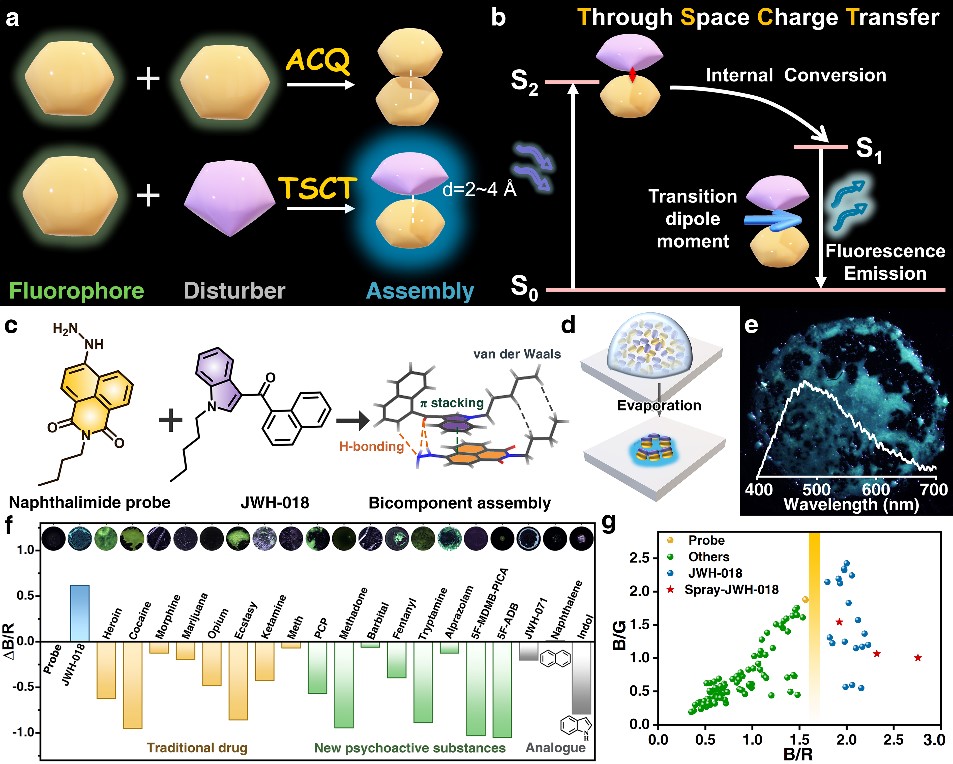Research Progress in ultrasensitive fluorescence sensing of synthetic cannabinoid JWH-018
Editor: | Feb 06,2023
Synthetic cannabinoids, with JWH-018 as a typical representative and thousands of structural variants, are classified as new psychoactive substances. They generally bind with the CB1 and CB2 receptors, which are similar as THC and CBD, the active components in marijuana, with up to 100 times stronger in potency, leading to serious side effects, such as cardiotoxicity, psychosis, epilepsy, and even suicidal ideation. On the other hand, synthetic cannabinoids are increasingly being abused as substitutes for traditional drugs due to their rich structural variants, powerful effects, and difficult regulation. For example, drug crimes involved synthetic cannabinoids continue to rise despite of the fact that the entirety of synthetic cannabinoids have been regulated since 2021. Therefore, the development of highly sensitive detection method for synthetic cannabinoids is of great significance to maintain human health and public security.
At present, the detection of synthetic cannabinoid substances mainly relies on large instruments, including high-performance liquid chromatography-mass spectrometry (HPLC-MS), meteorological chromatography-mass spectrometry (GC-MS), nuclear magnetic resonance (NMR), surface-enhanced Raman (SERS) and electrochemical methods. However, due to the tedious sample preparations, bulky and expensive instrumentations, high technical threshold, or susceptibility to the interference of coexisting substances, the in-field applications of these methods for rapid detection are severely limited. Compared to these techniques, the visual detection methods, namely colorimetry and fluorescence, owing to their direct result readout, portability, easy operation, and maintenance, are preferred for practical in-field detection. However, due to the simple structure with carbonyl linked alkyl chains replacing indoles and naphthalene rings, the synthetic cannabinoids represented by JWH-018 lack of recognition sites with high reactivity, making it difficult to conduct fluorescence probe design based on the traditional design strategy focusing on recognition groups. Therefore, how to propose a new fluorescence probe design concept via manipulating the photophysical properties of the assembly from the perspective of non-reactive electronic interaction between molecules, hence, to guide the probe structure design and develop new sensing methods for the rapid and specific detection of synthetic cannabinoid to solve these urgent problems remains a huge challenge.
To address these issues, Prof. Xincun Dou from XTIPC and his colleagues have proposed a brand-new fluorescence turn-on detection method based on the precise control of the droplet evaporation dynamics for intermolecular through-space charge transfer (TSCT) fluorescence emission enabled by bicomponent self-assembly. Following the strategy, they designed a naphthalimide fluorescence probe that could form multiple interactions with the synthetic cannabinoid JWH-018 to achieve the fluorescence turn-on sensing of JWH-018 with high sensitivity and specificity. Combined with theoretical calculations, the systematic studies revealed that the strong fluorescence emission of the probe-JWH-018 assembly with remarkable blue-shift is rooting in the intermolecular through space charge transfer in its S2 excited state. During droplet evaporation on the hydrophobic substrate, owing to the synergistic diffusion caused by capillary flow and Marangoni flow, the solute enrichment at the three-phase boundary leads to the boosted molecular collision, allowing the lamellated assembly of the probe and JWH-018 driven by the intermolecular interactions, including hydrogen bonding, π-π stacking, and Van de Waal’s interactions. With excitation, the intermolecular space charge transfer from JWH-018 to naphthalimide probe occurs in the S2 state of the assembly, resulting in specific greenish blue fluorescence. Besides, it is found that the inward motion of the three-phase boundary of the droplet could be well controlled by parameters, such as the surface tension of the substrate, the ambient temperature, and the droplet size, which is the basis of obtaining observable fluorescence sensing signals. The strategy realizes an ultra-low limit of detection (LOD) of 11 nmol/ml and great selectivity towards JWH-018, compared with traditional drugs (heroin, cocaine, morphine, marijuana, opium, ecstasy, ketamine, and meth), new psychoactive substances (PCP, methadone, barbital, fentanyl, tryptamine, alprazolam, 5F-MDMB-PICA, and 5F-ADB), as well as the structural analogues (JWH-017, naphthalene, and indole). The practicability is further verified by constructing a sensing chip for JWH-018 aerosol detection, which facilitates the on-site drug abuser screening with the naked eye.
Although the present exploration of the bicomponent assembly-enabled intermolecular TSCT is a proof-of-concept study, we expect it to provide a universal guiding inspiration for photophysical mechanism-dominated molecular recognition benefited by intermolecular interactions for other non-reactive chemical species, the optoelectronic materials design, assembly-based functional material conceptualization, etc.

Probe design strategy, TSCT mechanisms and specific fluorescence-on detection toward JWH-018
The research was published in Aggregate (DOI: org/10.1002/agt2.315) with the title of “Intermolecular through-space charge transfer enabled by bicomponent assembly for ultrasensitive detection of synthetic cannabinoid JWH-018”. The co-first authors are master student Chaogan Liu from Shihezi University and PhD student Fangfang Xiao from Xinjiang Technical Institute of Physics and Chemistry, Chinese Academy of Sciences. The corresponding authors are Prof. Xincun Dou, Dr. Yushu Li and Dr. Chengzhi Gu. This research was financially supported by National Natural Science Foundation of China, Xinjiang International Science and Technology Cooperation Program, the CAS Key Research Program of Frontier Sciences, and West Light Foundation of the Chinese Academy of Sciences.
https://doi.org/10.1002/agt2.315
附件下载:
 (86) 991-3838931
(86) 991-3838931 lhskj@ms.xjb.ac.cn
lhskj@ms.xjb.ac.cn (86)991-3838957
(86)991-3838957 40-1 Beijing Road
Urumqi, XinjiangChina
40-1 Beijing Road
Urumqi, XinjiangChina